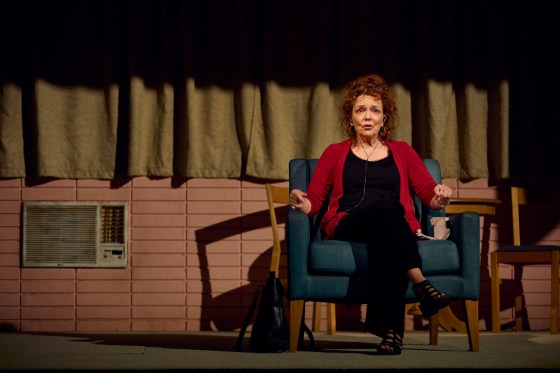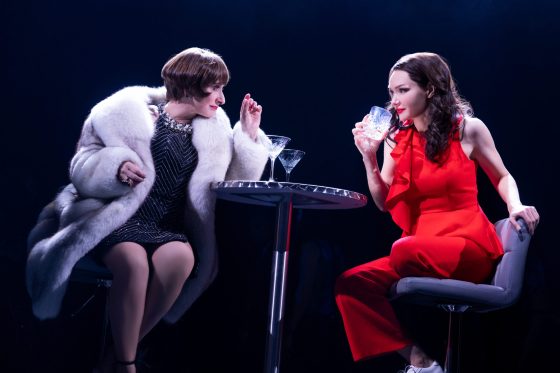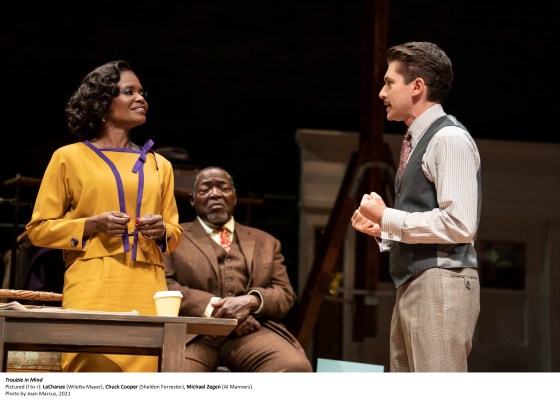One of the most sublime views of New York City is of lower Manhattan at night, while waiting in line for a show at St. Ann’s Warehouse on the Brooklyn waterfront. On the best nights, the skyscrapers of the financial district are perfectly reflected in the black mirror of the East River, like the world’s most talented four-year-old made an ink blot and folded it over.
For me, live theater returned one night in late September, waiting in just such a line. That experience, and nine others detailed below, underscores the best theater had to offer in this year when audiences returned, sometimes tentatively, to their seats and performers returned, most often triumphantly, to the stage.
[time-brightcove not-tgx=”true”]
Read More: Inside Broadway’s Jubilant Homecoming
Only an Octave Apart

That September night, I was waiting to see the premiere of Only An Octave Apart at St. Ann’s, the converted 1860 tobacco warehouse in DUMBO. Once inside, seated among the double masked (nose slippage brought the evil eye) the cliche would be “there was electricity in the air.” And while I don’t know about the physics of how sound travels from a performer’s vocal chords, throat and mouth to the audience’s ear, when Justin Vivian Bond and Anthony Roth Costanzo began singing, it felt like I was being physically bombarded (in a good way) by electrons of music particles. It was a profoundly moving performance, with the audience collectively realizing how much we had missed the fizz of a live performance.
A good measure of the thrill was watching how much two extremely talented and narcissistic performers, Bond a transgender cabaret fixture, and Costanzo, a full-fledged international opera star who usually performs at the Met, reveling in their connection and being in front of an audience again. Both are actual divas. On paper, pairing a (tall) gravel-voiced bedazzled downtown performance artist with a (short) opera star is a ludicrous notion, but it improbably works. The banter was spontaneous, intimate, and hilarious. Based on the audience reaction, unchecked glee, it’s likely that this irrepressible pair will eventually reunite. Try not to miss them when they do.
Blindness
Two entries on the list straddled pandemic restrictions. Blindness, based on José Saramago’s novel, adapted by British playwright Simon Stephens (his adaptation of The Curious Incident of the Dog in Night-Time won a Tony in 2015), opened in April, when many people were newly vaccinated. The show had socially distanced seats spaced widely apart and there were no live actors. Each audience member wore headsets and the account of a breakdown of society after a global pandemic is chillingly voiced by Olivier Award winner Juliet Stevenson (the play was first presented in London). The immersive sound design by Ben and Max Ringham was almost too effective. At times, Stevenson was whispering directly in one ear, then scrambling behind your back to resume in the other ear. The story was also almost too close to home for the pandemic-stunned audience. After the performance, the people I attended with stared speechlessly at each other, before wandering off into the night, dazed.
Read more about the best entertainment of the year: TV shows | Movies | Songs | Albums | Podcasts | Nonfiction books | YA and children’s books | Movie performances | Video games
Enemy of the People
Another stellar production in the socially-distanced, headset-supplied, single performer category was Enemy of the People. Commissioned by Park Avenue Armory during the pandemic, the retelling of the Ibsen play, about a different sort of health crisis, was adapted by Robert Icke and starred the remarkable Ann Dowd (Aunt Lydia in the The Handmaid’s Tale.) Playing multiple characters, Dowd was able to command the attention of an audience scattered throughout the 55,000 square-foot former drilling hall at separate cafe-style tables, despite the distraction of a gimmicky electronic voting button, which required audience participation and determined the direction of the play at various plot points.
Dana H. and Is This a Room

In addition to venue-supplied headsets, it was also a good year for transcripts. In a brilliant pairing, the Vineyard Theater staged Dana H. and Is This a Room, both based on verbatim transcripts. Is This a Room was a gripping drama taken from FBI transcripts of the raid and arrest of Reality Winner, a high-tech security worker who, spurred by conscience, leaked top-secret data on Russian interference in the 2016 elections. Reality Winner paid a steep price and was convicted and sentenced to more than five years in prison. The production was expertly paced, well-acted, entertaining and thought-provoking about important matters of individual responsibility and national policy. It ran in repertory with Dana H., the harrowing account of playwright Lucas Hnath’s mother, Dana H., getting kidnapped and held captive by a brutal member of the Aryan Brotherhood. The remarkable performance by Deirdre O’Connell had an extraordinarily high degree of difficulty and emotional toll. For the entire performance, O’Connell expertly lip synched recordings of interviews conducted with the actual Dana H., recounting her terrifying journey. The performance I attended left O’Connell in tears during the curtain call.
Assassins and Company

There were also two Stephen Sondheim productions made unfortunately timely by the composer’s death, at 91, in November. I found the Classic Stage Company’s production of Assassins problematic: fresh on the heels of the Alec Baldwin film set shooting, the acquittal of Kyle Rittenhouse and the latest school shootings, a production in which guns are practically the main character seems questionable, but maybe that’s part of the point. Ultimately, the caliber of the cast and the soulfulness of their performances carried the day. Company received a lavish Broadway production directed by Marianne Elliott, who has won multiple Tony awards, with gorgeous sets, a killer 14-piece orchestra and Patti LuPone’s show-stopping, bring-down-the-house, standing O rendition of “Ladies Who Lunch.” In the gender-shifted production, the Andrews Sisters-like “You Could Drive a Person Crazy” and “I’m Not Getting Married Today” also drove the audiences wild.
Caroline, or Change and Kimberly Akimbo

Sondheim is irreplaceable, but a leading contender as the dominant composer of musicals, Jeanine Tesori (Fun Home), also has two productions currently running in New York and both are outstanding. One is the third NYC revival of her collaboration with Tony Kushner, Caroline, or Change. I’ve seen all three and this crackling production is my favorite today. Tesori’s latest revelation, Kimberly Akimbo (with David Lindsay-Abaire, based on his play of the same name), is a near perfect night of theater. It is very funny, sad and incredibly fresh. The Off-Broadway production at the Atlantic Theater, starring Victoria Clark as a teenager who looks like she’s in her 70s, has recently been extended until next year and it would be a surprise if it did not eventually end up on Broadway.

Trouble in Mind

In 2021, the theater community took action to redress years of systemic racism, mounting more productions by creators of color. Perhaps no production embodied this more than the Roundabout’s powerful Broadway premiere Trouble in Mind. The 1955 play, by Alice Childress, a Black playwright and author who died in 1994, was headed toward Broadway but Childress refused to tone down its message about racism in the theater community and beyond. It belatedly gets a triumphant production, with a captivating performance by LaChanze, who previously won a Tony for her work in The Color Purple.
One good thing about seeing theater at the highest levels is that even less successful productions, ones that don’t make top 10 lists, have transcendent moments. Critics went to town on The Visitor at the Public Theater, and while much of the commentary was not misplaced, the staging and lighting was ephemeral. There was a moment when two characters were on the Staten Island ferry where water was rippling and dancing across the screen. It was a magical illusion that underscored the excitement and promise in the air each time the house lights dim and the curtain rises.
